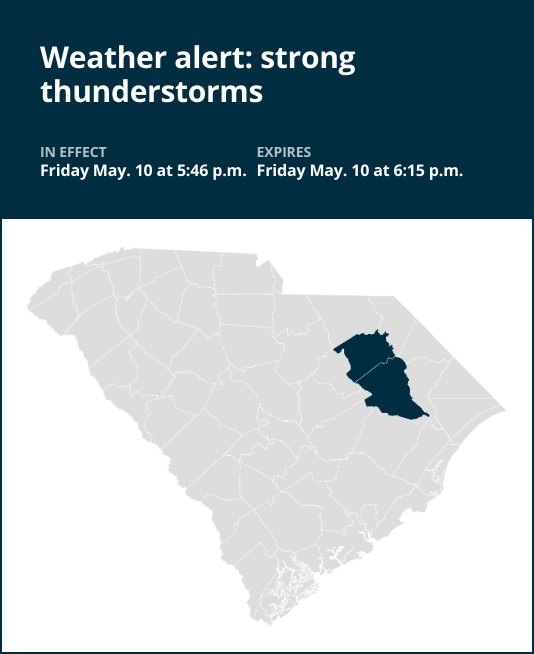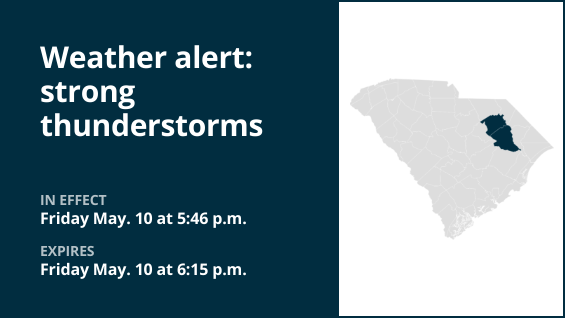A weather alert was issued by the National Weather Service on Friday at 5:46 p.m. for strong thunderstorms until 6:15 p.m. for Florence County.
Wind gusts of up to 50 mph and penny-sized hail (0.75 inches) are expected.
“At 5:45 p.m., Doppler radar tracked strong thunderstorms along a line extending from near Goodale State Park to near Hartsville. Movement was southeast at 40 mph,” says the weather service. “Gusty winds could knock down tree limbs and blow around unsecured objects. Minor hail damage to vegetation is possible.”
Expect strong thunderstorms in the following locations:
Oats, Lydia, and Swift Creek around 5:50 p.m.
Darlington and Darlington Raceway around 5:55 p.m.
Lamar and Florence Darlington Technical College Main Campus around 6:05 p.m.
Other impacted locations include Carolina Pines Regional Medical Center, Mcleod Regional Medical Center, Carolinas Hospital System – Cedar Tower and Health South Rehabilitation Hospital. This includes the following highways: Interstate 20 between mile markers 126 and 141. Interstate 95 in South Carolina near mile marker 146, and between mile markers 158 and 168.
According to the weather service, “If outdoors, consider seeking shelter inside a building. These storms may intensify, so be certain to monitor local radio stations and available television stations for additional information and possible warnings from the National Weather Service. A Severe Thunderstorm Watch remains in effect until 9 p.m. for northeastern South Carolina.”
This alert is in effect until 6:15 p.m.

Preparing for approaching lightning: Expert safety advice
Each year, lightning strikes the United States approximately 25 million times, with the majority of these electrifying events occurring during the summer months. Unfortunately, lightning is responsible for claiming the lives of approximately 20 people annually, as reported by the weather service. The threat of lightning becomes more pronounced as thunderstorms draw nearer, peaking when the storm is directly overhead and gradually waning as it moves away.
To guarantee your safety in the midst of a thunderstorm, take into account the following recommendations:
1. Lightning safety plan:When venturing outdoors, it’s crucial to have a lightning safety plan in place.
Monitor the sky for threatening signs and listen for the sound of thunder. If thunder is audible, it’s an indication that lightning is nearby.
Seek a safe place to shelter, preferably indoors.
2. Indoors safety measures:Once you’re indoors, avoid using corded phones, electrical devices, plumbing fixtures, and stay away from windows and doors.
These precautions help reduce the risk of electrical surges, as lightning can follow conductive pathways.
3. Wait for the all-clear:After the last lightning strike or thunderclap, wait at least 30 minutes before resuming outdoor activities.
Lightning can strike even when a storm has seemingly passed, so exercise caution.
When indoor shelter isn’t available:If you find yourself outdoors with no access to indoor shelter during a thunderstorm, take these steps to maximize your safety:
Avoid open fields, hilltops, or ridge crests, which expose you to greater lightning risk.
Steer clear of tall, isolated trees and other prominent objects. In wooded areas, stay close to lower stands of trees.
If you’re in a group, ensure that individuals are spaced out to prevent lightning current from transferring between people.
Camping in an open setting during a thunderstorm is strongly discouraged. If no alternative exists, set up camp in a valley, ravine, or other low-lying areas. Remember that a tent offers no protection against lightning.
Do not approach water bodies, wet objects, or metal items. Although water and metal do not attract lightning, they conduct electricity effectively and can pose significant risks.
In summary, when facing the threat of lightning, preparedness and vigilance are your best allies. By following these guidelines, you can significantly reduce the likelihood of lightning-related incidents and prioritize your safety.
Navigating rainy roads: Safety tips for wet weather
When heavy rain sets in, the risk of flooding and hazardous driving conditions rises. Whether it’s prolonged rainfall or rapid runoff, being prepared is essential. Here are some valuable safety tips from the weather service to ensure you stay safe in heavy rain:
Beware of rapid water flow:Avoid parking or walking in close proximity to culverts or drainage ditches, as the swiftly moving water during heavy rain can potentially carry you away.
Maintain safe driving distances:Adhere to the two-second rule for maintaining a safe following distance behind the vehicle in front of you. In heavy rain, allow an additional two seconds of distance to compensate for reduced traction and braking effectiveness.
Slow down and stay cautious:If it is raining and the roads are wet, slow down. Take your foot off the accelerator and let your speed drop gradually. Never use the brakes suddenly because this may cause the car to skid.
Choose your lane wisely:Stick to the middle lanes on multi-lane roads to minimize the risk of hydroplaning, as water tends to accumulate in outer lanes.
Visibility matters:Turn on your headlights and be careful of other vehicles to the rear and in blind spot areas as they are especially difficult to see through rain-spattered windows.
Watch out for slippery roads:The first half-hour of rain is when roads are slickest due to a mix of rain, grime, and oil. Exercise heightened caution during this period.
Keep a safe distance from large vehicles:Don’t follow large trucks or buses too closely. The spray created by their large tires reduces your vision. Take care when passing them as well; if you must pass, do so quickly and safely.
Mind your windshield wipers:Overloaded wiper blades can hinder visibility. If rain severely limits your sight, pull over and wait for conditions to improve. Seek refuge at rest areas or protected spots.
When stopping by the roadside is your only option, position your vehicle as far off the road as possible, ideally beyond guardrails. Keep your headlights on and activate emergency flashers to alert other drivers of your position.
By following these safety measures, you can significantly reduce risks and ensure your well-being when heavy rain pours down. Stay informed about weather conditions and heed advice from local authorities to make your journey safe and sound.







